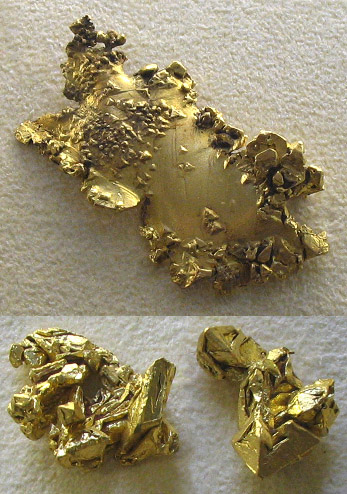| << Chapter < Page | Chapter >> Page > |
Gold is a symbol of wealth, prestige, and royalty that has attracted and fascinated people for many thousands of years (see Figure Native Gold ). Gold is considered by many to be the most desirable precious metal because it has been sought after for coins, jewelry, and other arts since long before the beginning of recorded history. Historically its value was used as a currency standard (the gold standard) although not anymore. Gold is very dense but also very malleable; a gram of gold can be hammered into a 1 m 2 sheet of gold leaf. Gold is extremely resistant to corrosion and chemical attack, making it almost indestructible. It is also very rare and costly to produce. Today the primary uses of gold are jewelry and the arts, electronics, and dentistry. The major use in electronics is gold plating of electrical contacts to provide a corrosion-resistant conductive layer on copper. Most gold is easily recycled except for gold plating due to combinations with other compounds such as cyanide. About half of the world’s gold ever produced has been produced since 1965 (see Figure World Gold Production ). At the current consumption rate today’s gold reserves are expected to last only 20 more years.


There are two types of gold ore deposits: (1) hydrothermal , where magma-heated groundwater dissolves gold from a large volume of rock and deposits it in rock fractures and (2) placer , where rivers erode a gold ore deposit of hydrothermal origin and deposit the heavy gold grains at the bottom of river channels. Although gold’s resistance to chemical attack makes it extremely durable and reusable, that same property also makes gold difficult to extract from rock. As a result, some gold mining methods can have an enormous environmental impact. The first discovered gold ore was from placer deposits, which are relatively simple to mine. The method of extracting gold in a placer deposit involves density settling of gold grains in moving water, similar to how placer deposits form. Specific variations of placer mining include hushing (developed by the ancient Romans where a torrent of water is sent through a landscape via an aqueduct), sluice box (where running water passes through a wooden box with riffles on the bottom), panning (a hand-held conical metal pan where water swirls around) and hydraulic (where high pressure hoses cut into natural landscapes, see Figure Hydraulic Mining ). Hydraulic mining , developed during the California Gold Rush in the middle 1800s, can destroy natural settings, accelerate soil erosion, and create sediment-rich rivers that later flood due to sediment infilling the channel. The largest gold ore body ever discovered is an ancient, lithified (i.e., hardened) placer deposit. Nearly half of the world’s gold ever mined has come from South Africa’s Witwatersrand deposits, which also have the world’s deepest underground mine at about 4,000 m. To increase the efficiency of gold panning, liquid mercury is added to gold pans because mercury can form an alloy with gold in a method called mercury amalgamation . The mercury-gold amalgam is then collected and heated to vaporize the mercury and concentrate the gold. Although mercury amalgamation is no longer used commercially, it is still used by amateur gold panners. Unfortunately, considerable mercury has been released to the environment with this method, which is problematic because mercury bioaccumulates and it is easily converted to methylmercury, which is highly toxic.

Today most gold mining is done by a method called heap leaching , where cyanide-rich water percolates through finely ground gold ore and dissolves the gold over a period of months; eventually the water is collected and treated to remove the gold. This process revolutionized gold mining because it allowed economic recovery of gold from very low-grade ore (down to 1 ppm) and even from gold ore tailings that previously were considered waste. On the other hand, heap leaching is controversial because of the toxic nature of cyanide. The world’s largest cyanide spill to date occurred at Baia Mare in northern Romania (see Figure Baia Mare ). In January 2000 after a period of heavy rain and snowmelt, a dam surrounding a gold tailings pond collapsed and sent into the drainage basin of the Danube River 100,000 m 3 (100 million liters) of water with 500 - 1,000 ppm cyanide The U.S. EPA allows no more than 0.2 ppm cyanide in drinking water. , killing more than a thousand metric tons of fish (see Figure B aia Mare Cyanide Spill ). Considering the large environmental impact of gold mining, this may take some of the glitter from gold.



Notification Switch
Would you like to follow the 'Sustainability: a comprehensive foundation' conversation and receive update notifications?